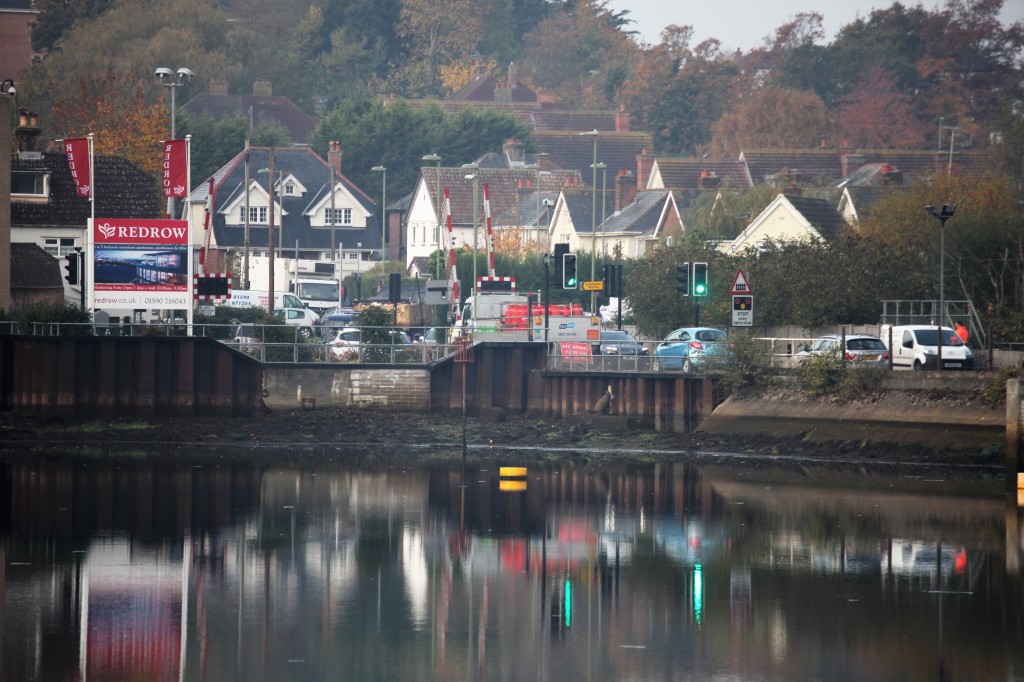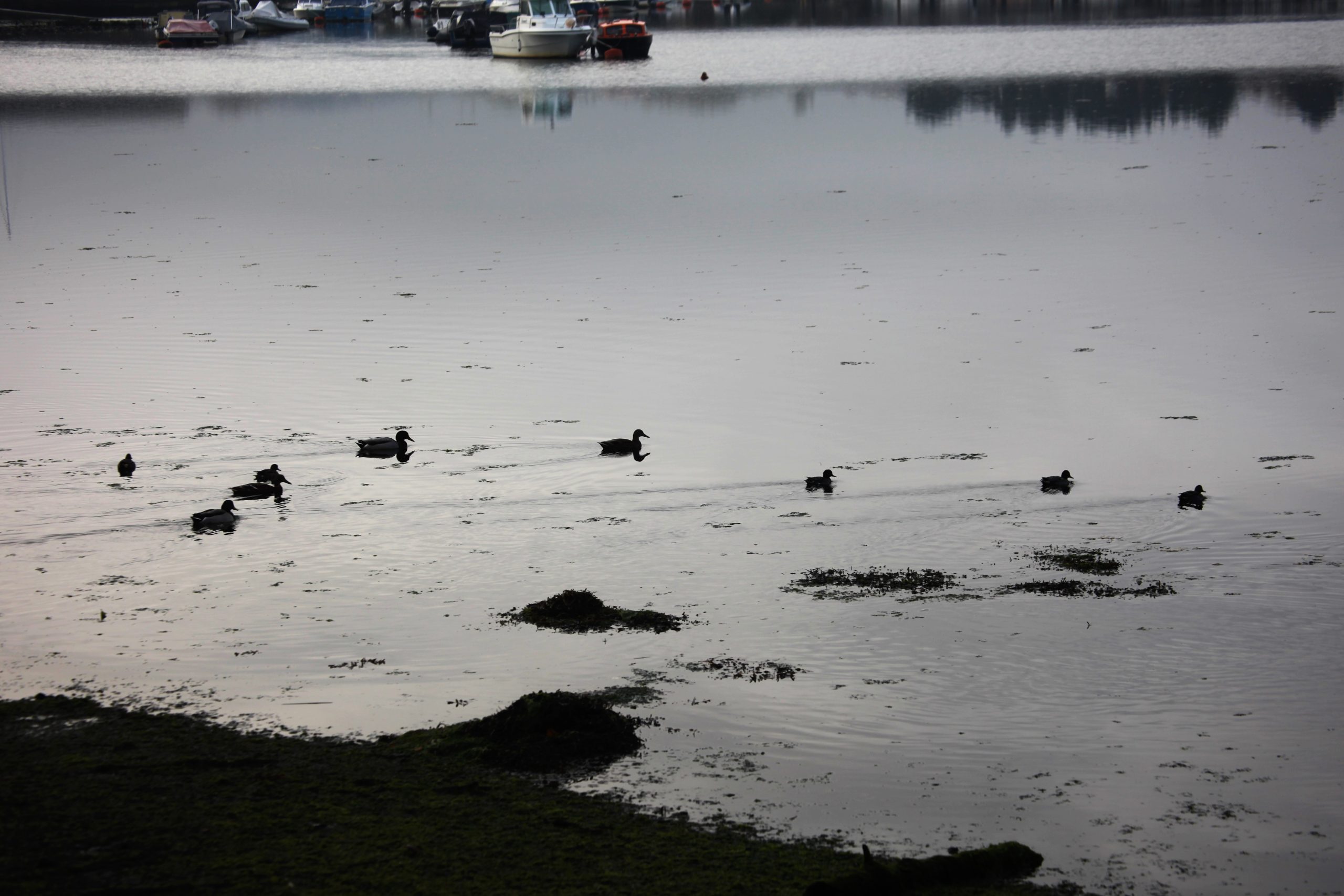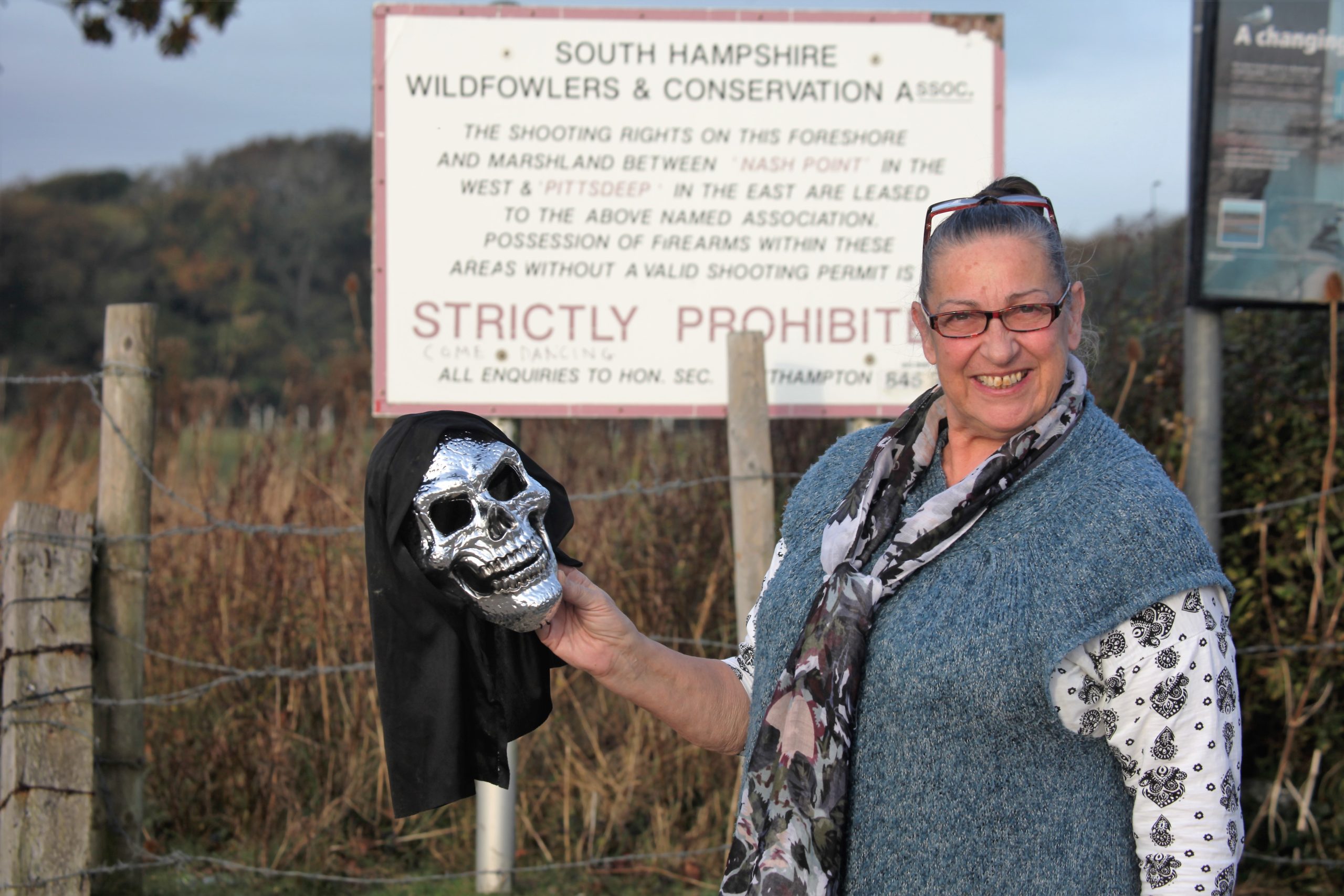CLICK ON SMALLER, CLUSTERED, PICTURES TO ACCESS LARGER GALLERIES
On quite a misty morning, we went out for a drive in such a direction as the spirit moved us.


We crossed the Lymington River and turned right along Undershore Road, giving us an atmospheric view of the level crossing we had just passed over.

Just to the left of my vantage point, a duck led her paddle of ducklings onto the water from the muddy bank.

Originally heading for Hatchet Pond we diverted to Tanners Lane, along which was walking a blonde woman with her equally slender and elegant saluki, who were soon to join us on the beach,

where Jackie found the skull of the spirit that had led us there,





and I photographed the sun, the sea, birds overhead, the shingle, the invisible Isle of Wight, a beached boat, and a ferry.

We travelled on in the vicinity of Sowley where the obligatory pony stood hopefully in the middle of the road



and pheasants sped across a field.

Snooks Lane near Portmore led us back to Lymington and home.
I have not dwelt on my daily continuing wrestling with uploading my pictures. Suffice it to say that James Peacock made another visit, bringing his own Apple laptop to try that. The problems were the same, leading us both to the conclusion that the problem lies in the BT internet connection. James is to investigate the possibility of getting this improved.
When we made our first visit to the New Zealand graves at Brockenhurst, I bought two books on the subject. I finished reading the first, Clare Church’s “New Zealand Graves at Brockenhurst”, this afternoon.
This is a well researched and beautifully produced A4 size laminated paperback. In tracing the antecedents of these young men who died in WW1, the conflict that was supposed to end all wars, we learn much about the early European settlement of New Zealand. It was only in 1840 that the first British immigrants came to join the Maoris who had come from Polynesia before the 14th. century.
It was only in 1909 that the New Zealand Army was formed, yet it sent more than its fair share to join the 1914-18 conflict, and to die in foreign fields, and in the New Zealand General Hospital No. 1 in Brockenhurst. Almost as many succumbed to illness as to wounds. A proportion of the men were Maoris.
Those of European origin mostly emanated from parts of the UK, notably Scotland. We learn their civilian occupations, and those of their antecedents. As one would expect there was a preponderance of farmers and craftsmen.
The agonies of the men and of their bereaved families are apparent in their factually related stories.
This evening we dined on Jackie’s delicious liver casserole, served with saute potatoes on a bed of peppers, leaks, garlic, and mushrooms. Dessert was cherry crumble and custard. I drank Abbot Ale.
Having spent far too many hours attempting to load today’s photographs onto WordPress, and feeling like the spider of the legend of the Scots king Robert I, I am forced to leave gaps above, which I hope to fill in due course.
Education Scotland’s website, www.educationscotland.gov.uk/scotlandshistory/…/robertbruce/
explains: “It is said that in the early days of Bruce’s reign he was defeated by the English and driven into exile. He was on the run – a hunted man. He sought refuge in a small dark cave and sat and watched a little spider trying to make a web.
Time and time again the spider would fall and then climb slowly back up to try again.
If at first you don’t succeed – try, try again.
Finally, as the Bruce looked on, the spider managed to stick a strand of silk to the cave wall and began to weave a web. Robert the Bruce was inspired by the spider and went on to defeat the English at the Battle of Bannockburn.
The legend as it is now told was first published by Sir Walter Scott in ‘Tales of a Grandfather’ in 1828, more than 500 years after the Battle of Bannockburn. It is thought that Scott may have adapted a story told about Sir James Douglas.
Caves across Scotland and Ireland are said to be legendary cave of Bruce and the spider: the King’s Cave at Drumadoon on Arran; King Robert the Bruce’s Cave in Kirkpatrick Fleming near Lockerbie; Bruce’s Cave – Uamh-an-Righ, Balquhidder Glen; Bruce’s Cave on Rathlin Island…”
Early the next morning I managed to load the rest of the pictures.


I’m sorry the photos are missing – I wanted especially to see the skull of the spirit! The spider photo is brilliant!! And the book sounds interesting!
Many thanks, Pauline. I wondered what you’d think of the book. The pictures are all now on. The spider photo is from an earlier post, so was already in WordPress.
😀 😀 😀 the spirit!! You certainly wrote a good review of the book – I do like historical books that present the times through the experiences of the common man rather than war movements, if you know what I mean.
I do, Thanks again, Pauline
It sounds like you had a great day. I was wondering about the picture, thought it was my computer who messed up. Almost glad to read comment above.
Thanks very much, Bridget
Sorry you’re still having technical problems–the photos that did make it are lovely, though I was also eager to see “the skull of the spirit.” I like the reflections of the buildings in the river.
Many thanks, Merril. All the pictures are now on.
Beautiful, Derrick! (Jackie seems to be enjoying that skull.) 🙂
Thanks a lot, Merril
I was really drawn to that second photo, Derrick. There’s something about it.
I’m no expert on spiders, but that one can’t be good!
Thanks very much, Jill. That spider was lurking between beach huts some time ago
I presumed the woman’s “slender and elegant saluki” was some sort of motorbike, until I googled it!
🙂 Thanks, Bruce
What a cool story.
Thank you, Leslie. It has a useful message
What an interesting story.
Thank you, Kim. It’s one we grow up with
I remain doubtful that anything made with liver can be delicious but perhaps if it’s washed down with enough wine it is at least swallowable. As for the photo uploading issue all is can say is “Technology. ARGH!”
Thanks very much, Susanne
It’s interesting that spiders seem to tell tales that can edify despite their slightly fearsome appearances. Think of Charlotte’s Web, a fanciful tale but much read and appreciated by many.–The spiders are sneaking into our place now that the cool rains are here…I captured two the other day and back outside they went.
Thank you, Cynthia. Do you know of Anansi? Whether or not you do, I think you will find that this post appeals to the therapist in you: https://derrickjknight.com/2013/10/07/anansi/
I do! Thanks for reminding me. And I enjoyed your other post, as well–so glad they got to create a few bridges.
Thanks a lot, Cynthia
How frustrating for you to still be having technical troubles. You need to be like that persistent spider that never gives up!
Thanks, Miriam. I don’t know how to give up 🙂
Good for you.
What an interesting story! It compensated well the lack of photographs this time. The photo of the ducks is splendid. Sounds like you had a mysterious cum nostalgic type of day 😀
Many thanks, Geetha. Photographs now on.
Great! Will have a look when am back to the computer
That Mallard might well have left it too late if she’s got ducklings as small as that in November. You have my sympathies about loading photographs. Computers are so frustrating when there is something that they won’t do.
Many thanks, John. There are quite a few new ducklings around here. Fingers crossed for them
I feel your pain …. I do hope the problems will be resolved quickly now that James is onto the root cause. The pictures though are delicious and I thank you for taking the painstaking time to share them and I am most interested in the Brockenhurst books – you have piqued my interest to learn more about the New Zealanders who travelled half a world to die in foreign fields and hospitals. And Robert the Bruce – I’m a direct descendent – a fact I was particularly proud of as a child and as a result named my tartan trousered teddy bear Bruce.
Now that is a great story, Osyth, of which you were rightly proud. Many thanks.
What a gorgeous commune with nature. I’m not a big fan of spiders, but you have to admire their tenacity with web building. I think we all have to go back and fill in the gaps as the days are filled with so much. Great tale!
Many thanks, LT
The spider and horse were two interesting creatures (but not from the “black lagoon!”) I liked the tone in your writing, like a conversation as we strolled and drive along yours and Jackie’s journey for the day.
Derrick, i liked the dramatic skeleton head photo, we call November first~ All Saints Day, so this is a “lost soul” mask, in my mind. 🙂
The invisible Island of Wight still had some atmospheric shots and wistful feelings. . . Take it easy, Derrick!
Very many thanks, Robin. Sound advice 🙂
I love those drives when you go where the spirit takes you and just enjoy! Lovely pictures derrick
Many thanks, Lynn
Are all the ponies you photograph wild or do they actually belong to the natives and are allowed o roam free? They seem to be everywhere. XD
They are everywhere, and are owned but roam free. It is an age-old tradition. http://www.thenewforest.co.uk/discover/new-forest-ponies.aspx Thank you, Brian
It is always wonderful to go along with your spirit 🙂 Thanks
Thank you very much, Lakshmi
Lovely photos. I’m glad you were able to upload them in the end.
Thanks for the brief history lesson. 🙂
Thanks very much for this comment, and for all the reading, Timi.
Great to revisit and see the photos that you described. You are a wonderful storyteller with your words as well as your photos. Technical difficulties didn’t slow you down at all. 🙂
Many thanks, Oglach. Thanks for going back, too
My pleasure, and thank you.